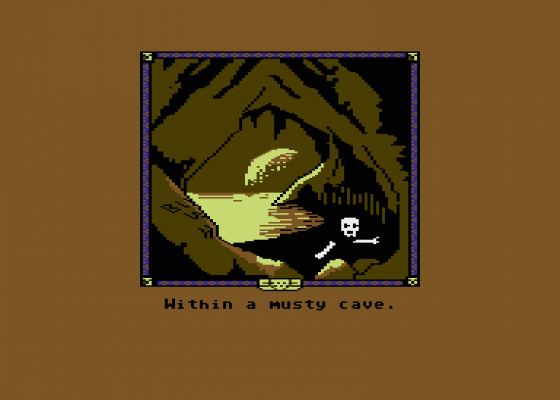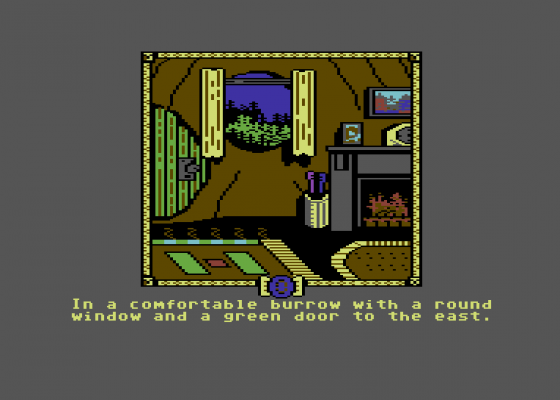
Commodore User
 1st February 1986
1st February 1986
Author: John Ransley
Publisher: Melbourne House
Machine: Commodore 64
Published in Commodore User #30
Lord Of The Rings
The Hobbit still probably holds the record for being the world's biggest-selling adventure ever. So reviewing Lord Of The Rings isn't so much a question of accessing a sequel as meeting the heir to a legend.
Prising open the weighty package (it includes a paperback copy of Tolkien's 529-page novel, The Fellowship Of The Ring - the first in the trilogy that forms the basis of this game) you feel a little like Indiana Jones peering into the Lost Ark of the Covenant. The first nice surprise is that you're getting not one but actually three self-contained adventures for your £15.95.
The first is a beginner's game - a cut-down version of one of the full adventures that nevertheless incorporates all the main locations, objects and characters. The big plus is that calling for HELP whenever a problem is encountered produces a useful hint. Otherwise, it is much the same in looks and play characteristics as the two full-blooded, HELPless adventures that make up the trio.

It was The Hobbit, aided and abetted to some extent by Twin Kingdom Valley, that broke the mould of text adventures when it first colourfully breathed life into millions of screen pixels back in 1983, and so it is natural to make The Lord Of The Rings' visual appeal the first point of comparison with its predecessor.
The running screen display comprises three overlapping rectangles with a description and occasional graphic representation of one's current location appearing in the foreground. The borders of the subordinate rectangles hold the images of your travelling companions, which move from the hindmost border to the foremost, and then back again, according to their proximity to the character you have assumed.
First impressions are that Lord Of The Rings is very much more textual than The Hobbit, sometimes using up two scrolling screenfuls of text to describe a single location. The graphics are satisfactory but they do not mark any significant advance over those presented in The Hobbit.

Still, faintly disappointing graphics should not detract from Lord Of The Rings's excelent in so many other respects. Philip Mitchell's renowned Inglish parser seems to have been refined still further to permit even more effortless exploration of Middle Earth using commands as simple or as complex as one likes. Its 800-word vocabulary can cope with conventional commands such as EXAMINE THE RING or CLIMB THE TREE without blinking a cursor. But it's more fun still to start lacing your sentences with prepositions such as in ATTACK THE GUARD WITH THE SWORD AND TAKE THE SWORD FROM THE TABLE. A single entry could be composed of several such sentences, punctuated with commas and full stops as with ordinary English, up to a maximum of 128 characters long.
Another technique pioneered in The Hobbit and happily continued in Lord Of The Rings is the ability to converse more or less naturally with your travelling companions and other characters, and even to instruct them to take certain actions. For example, one can SAY TO MERRY "GIVE THE ORC THE EMERALD" - or in a shorthand version of the some kind of command, SAM "GIVE MAP TO FRODO". Intelligent and apt use of the SAY command or its derivatives is absolutely crucial to your successful completion of this adventure, since many situations rely on a form of esprit de hobbitsrather than individual action by the character you choose to play. Just don't expect others always to obey your edicts - the inhabitants of Middle Earth have minds and allegiances of their own.
A quite surrealistic variation on this theme is that, having once chosen whether to assume the persons of FRODO, MERRY, SAM or PIPPIN at the beginning of each game, one can at any time switch to being another character with the simple command BECOME MERRY. You'd be well advised to explore the adventure in a single role before calling this facility into use - though you could find it invaluable if, for example, you, as FRODO, feel compelled to sacrifice one of your compatriots in attempting a rather dangerous action!

More practically, one can by this means split up the original party and have individual members of the quartet separately travelling around different parts of the Shire, for example, and testing the challenges and conditions to be found there.
As in all microadventuring, you must map your travels and, since Lord Of The Rings permits movements to eight points of the compass, you'll find it best to plot your progress on a grid of hexagonals. It gets even more interesting when you call up the option to track a character, such as FOLLOW GREEN KNIGHT without knowing in which direction he is going. You are also bound to become involved in combat, and here it is necessary to specify both the weapon and your victim, as in KILL WARG WITH AXE.
Wounds slow one's progress, as will weariness and lack of food. So take sustenance wherever you can find it, and don't forget to REST now and then. Other key commands always worth trying include LOOK, EXAMINE and WAIT. You can also check your SCORE at any point, PAUSE the game (which is quite different from the command WAIT), check your INVENTORY, and SAVE a particular game to tape before either attempting a risky action or powering down for the night.

When you have finally mastered your first quest, you may perhaps choose to switch tapes and encounter the Black Riders, the orcs of Moria, the dreaded realm of Angmar and of course the evil Sauron all over gain in the second, self-contained full adventure, possibly taking time to dip into The Fellowship Of The Ring meantime to give you some more clues to your best strategy.
Overall, Lord Of The Rings does more than serve as a worthy sequel to The Hobbit, for it has a character and depth all of its own.
Attention to detail, brilliant parser logic, character interaction and the sheer potential for hours and hours of absorbing entertainment, make Lord Of The Rings a totally irresistible addition to the ranks of all-time micro-adventure classics.
Other Commodore 64 Game Reviews By John Ransley
Scores
Commodore 64 Version| Graphics | 70% |
| Literary Merit | 90% |
| Intelligence | 70% |
| Toughness | 70% |
| Value For Money | 90% |
| Overall | 78% |











